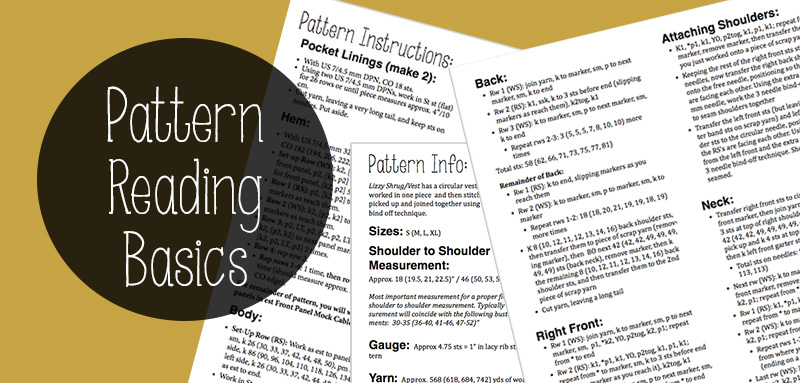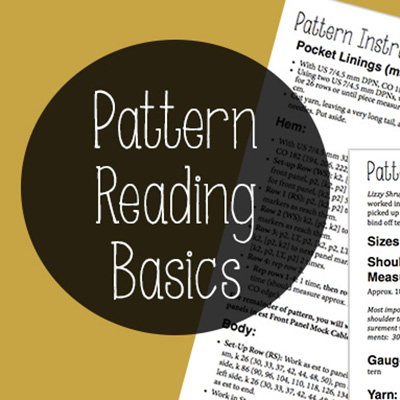
I’ve very lucky that as a designer I also work at my local yarn shop. I get to hear first-hand, in person, the most common knitting questions and this helps me to make sure I’m writing my patterns as clearly as possible. The internet allows me to connect to knitters all around the world (which is amazing when you think about it!), but I’ve learned that talking to knitters face-to-face and helping them solve their problems in person is truly invaluable.
One of the common questions I get is about pattern reading and verbiage used in patterns. It can be a tricky question because all designers write in a different manner, depending on their own personal preferences or based on the preferences of the yarn company they are designing for (if they aren’t self-publishing). But what I can do is provide some pattern reading basics for my particular style of pattern writing and the common verbiage I use. This should help you in not only reading my patterns, but this info is general enough that it should help you with other designer’s patterns as well. I’m guessing this will just be “Part 1” and as time goes on I will do additional posts about other pattern reading basics.
Pattern Reading Basics:
“; Repeat from * to end”:
Example: k1, *p1, k1; rep from * to end
- You will repeat the instructions that are in between the * and the ; – in this example, that means you will first k1, then you will p1, k1, and then you will continue working p1, k1 until you reach the end of the row or round.
Example: k1, *p1, k1; rep from * 2 times
- Very similar to the above, but you are being instructed to repeat the instructions in between the * and the ; a certain amount of times. Keep in mind the “2 times” is in addition to the first time you worked the p1, k1.
“[ ] to end”:
Example: k1, [p1, k1] to end
- When instructions are in brackets, it means that the instructions that follow the brackets just apply to what’s in the brackets. In this example you will first k1, then you will p1, k1 to end.
Example: k1, [p1, k1] 2 times.
- Very similar to the above, but you are being instructed to repeat what’s in the brackets a certain number of times. Unlike the first asterisk example, when it says “2 times” after the brackets it means you will only work the p1, k1 sequence 2 times total.
“Repeat “x” times”:
Example: Repeat rows 1-4: 3 times.
- This means that you will work rows 1-4, and then you will repeat rows 1-4 a total of 3 more times, so for 12 additional rows. So in total, you have worked 16 rows.
“Work as established”:
Example: Work as established for 20 rows or until measures 4â€.
- When the “as established” language is used, it means that you will continue working in the manner that you have been in the previous section of the pattern. In this example, let’s say that in the previous section you had been working in Seed Stitch. So upon reading the instruction “Work as established”, that means you will continue working in the same Seed Stitch pattern that you had previously been doing, and to do it for 20 more rows or until your work measures 4″.
“Or until measures…”:
Example: Knit 10 rows or until measures 2″
- The reason for giving both a row count as well as a measurement is because sometimes people cannot obtain the right row gauge for the pattern. Typically stitch gauge is the most important of the two (a pattern will note if this is not the case), and sometimes when you get the right stitch count you won’t necessarily also get the right row gauge. So by giving by row count as well as measurement, it’s a way to ensure you are going to get the right length even if your row gauge is off.
Right Side/Left Side:
- In knitting, when the right side/left side is mentioned, it’s from the perspective of wearing the garment. So if you are knitting a sweater and starting at the bottom, the pattern may reference the “Left Front” – from the perspective of knitting the garment, this “left front” is the front on your right side and the “right front” is the front on your left side. So always remember to visualize the piece as if you are wearing it.
What does an “x” mean?
Example: Sizes XS, M & L Only: k 2 (x, 4, 5, x)
- You will see an “x” if the instructions being given are for only for particular sizes. The “x” is used as a placeholder for the sizes not affected by these instructions. So in the above example, because the instructions are not for sizes S or XL, those spots have a placeholder “x”.


Hi Elizabeth,
We met yesterday at the Knit Wit shop. You so kindly answered my many questions especially those dealing with casting on. Last night and this AM I worked on the “thumb method” that your grandmother taught you and it really did help me cast on the 120 stitches I needed to begin my cowl. Thank you! Thank you! Thank you! Your thumb method gave me more control over the tension aspects of casting on. I’m still awkard, very awkard but feel much more in control of the process.
Soon we will need to leave Portland and head back home to KC. Now, though, I have your web site to browse and can dream about my next project not being limited by fears of high numbers of cast ons limiting my dreams.
Thanks again. Meeting you and our conversation yesterday will be one of the highlights of our trip. My husband Bob and I will be sending lots of prayers and good wishes for you and Jeff your way until we meet again at the Knit Wit.
Judy
Hi Judy,
It was so nice to meet you and Bob as well! And so glad the casting-on trick worked well for you! Yeah! I hope you enjoyed the rest of your trip and had safe travels back home. Looking forward to seeing you on your next trip up and thanks so much for keeping us in your thoughts and prayers 🙂
Best,
Elizabeth